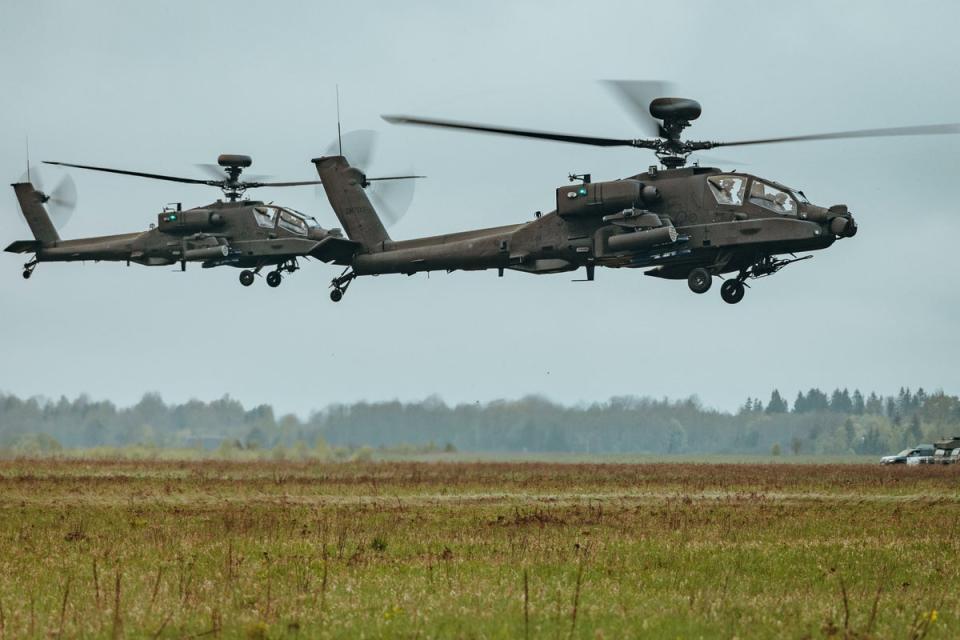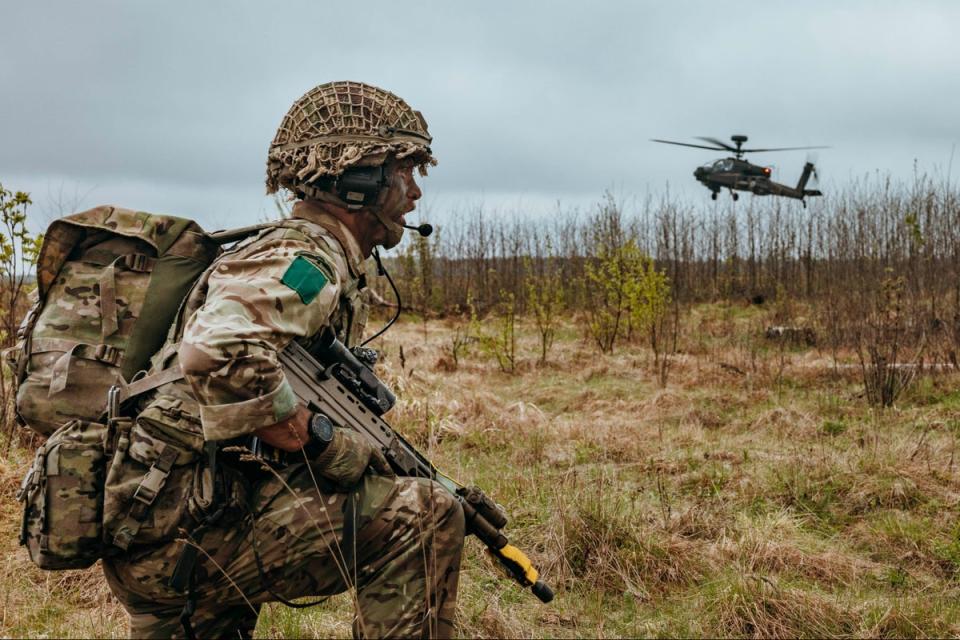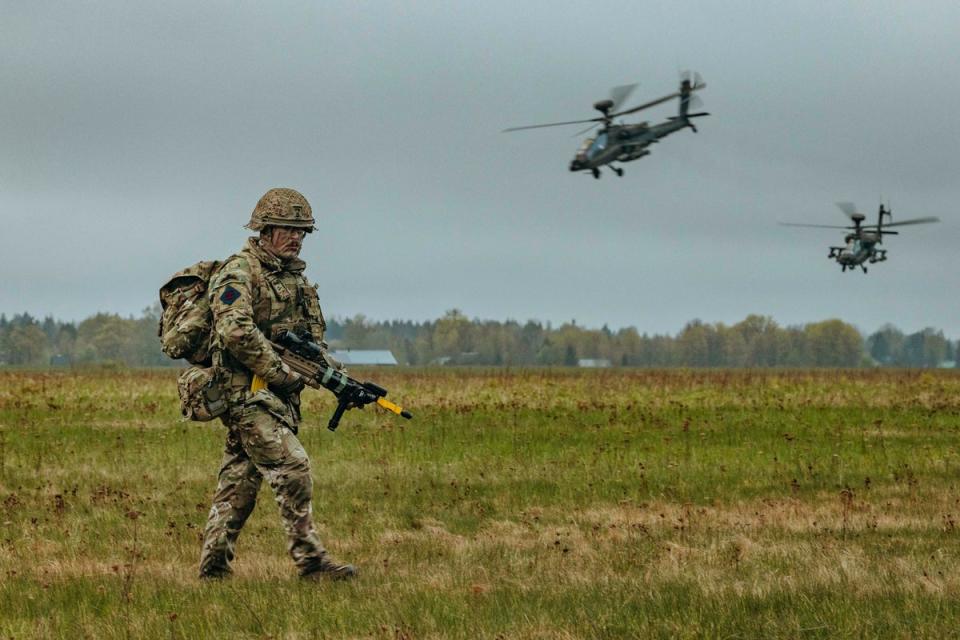“We are ready to fight”

Apache attack helicopters are supporting ground troops storming Russian positions. Several fortified trenches were cleared in fierce close-quarters fighting and a counterattack with drones and missiles was repelled.
The Swift Response mission is being carried out by the British-led forces in Estonia. It is part of the largest NATO military exercises since the end of the Cold War, stretching from the Baltics to the Balkans, and comes against the backdrop of an increasingly heated confrontation with Moscow following Vladimir Putin’s invasion of Ukraine.
There have been repeated warnings from the opposing sides, NATO and Moscow, of a possible conflagration. What is unfolding in Estonia is the first sign of a modern conflict between major powers, with the Western alliance taking up positions on the eastern flank.
The stakes could hardly be higher. President Putin has raised the possibility of using nuclear weapons on several occasions, while ratcheting up his warning rhetoric to the West since the Ukraine war began. NATO’s response appears to be “prepare for the worst, hope for the best” and watch to see what the Kremlin does next.
Standing in a muddy field in Nurmsi in central northern Estonia – a two-hour tank ride from the Russian border – Brigadier Giles Harris, commander of British forces in the Baltics, is in no doubt about the urgent need to confront the clear and present threat from the Kremlin.
“It’s very urgent. I’m not going to guess what might or might not happen, but as military personnel, it’s our job to be ready. There’s no point in waiting to be ready, we should get ready now. And what’s happening in Ukraine is teaching us the lessons we need to learn,” he says.


“Our mindset is that whether it’s today or tomorrow or next year, we need to be as prepared as possible, we need to prepare as best as we can. We are prepared to defend every inch of Estonian soil if necessary. In the minds of the soldiers, the strategic purpose and context in which we are conducting this training has definitely changed (compared to regular exercises). The fact that we are doing this so close to Russia highlights why it is so important to be here.”
More than 90,000 troops from all 32 NATO member states are taking part in the Steadfast Defender exercise, which also includes Swift Response. The exercises include air strikes, tank maneuvers and fire support and take place in locations such as Estonia, Sweden, Poland, North Macedonia, Romania, Hungary and Moldova.
Brigadier General Mark Berry, commander of the 16th Air Assault Brigade, in which the Parachute Regiment plays a leading role, wanted to stress that the exercise was not just a show of force.
“I never view my soldiers’ activities as a show. My role is to ensure that soldiers have the right training opportunities and feel ready and prepared to work with allies or alone,” he says.
“We are of course sending messages to anyone who will listen. We want to make it clear that our forces are ready… (that) they are capable of working together. In any specific time frame when we train, we look for experiences from conflict areas, anywhere where there is a lesson we can use.”


For Lieutenant Colonel David Lambert of the Army Air Corps, this is a “milestone.”
“The training is really as realistic as it can be,” he says. “There’s nothing artificial about it. It’s equally good training from the lowest level to the highest. We’re ready to fight today.”
The events in Ukraine are analyzed and used to coordinate war games, ranging from the diverse use of drones and cyber warfare to the defense of massive advances used by Russian forces in battles such as the Bakhmut “meat grinder” in Donbass.
Lessons can also be learned from avoiding casualties. One example is the large number of Russian commanders killed in Ukraine. Kyiv says there are 13, but the Kremlin admits there are seven.
One reason for this, analysts say, is that Russian high-ranking officials often made themselves conspicuous targets by staying in one place and parking their vehicles, which were connected to antennas, next to each other.


During the exercise, NATO forces practice not remaining static in one position for too long, but being mobile, ensuring adequate logistics and keeping an eye out for signs that they are being pursued by the enemy. Another means of avoiding attack is to move command and control of operations further back while ensuring that communications are maintained.
Troops from 16 Air Assault and other forces fighting in Britain’s wars abroad have had their most recent combat experience in Afghanistan and Iraq. War in Europe brings different challenges, which is why exercises such as Swift Response are essential.
Different dynamics have led to different tactics.
Armoured personnel carriers fitted with the Weapons Mounted Installation Kit (WMIK) were very popular with mobile British units, including special forces. However, their open top and light armour made them particularly vulnerable to roadside bombs and so they were withdrawn from service.
They have experienced a new lease of life in the Parachute Regiment. One reason for this is that they are light enough to be carried by transport aircraft or Chinook heavy-lift helicopters and can therefore be deployed quickly if, for example, there is a Russian incursion across the border.
Standing next to a WMIK in Nurmsi, Corporal Ashis Thami said: “Of course we know what happened in Afghanistan. But we find it very useful to travel around such places and provide force protection. We are told we have to be ready for different wars at different times and I think that is right.”



